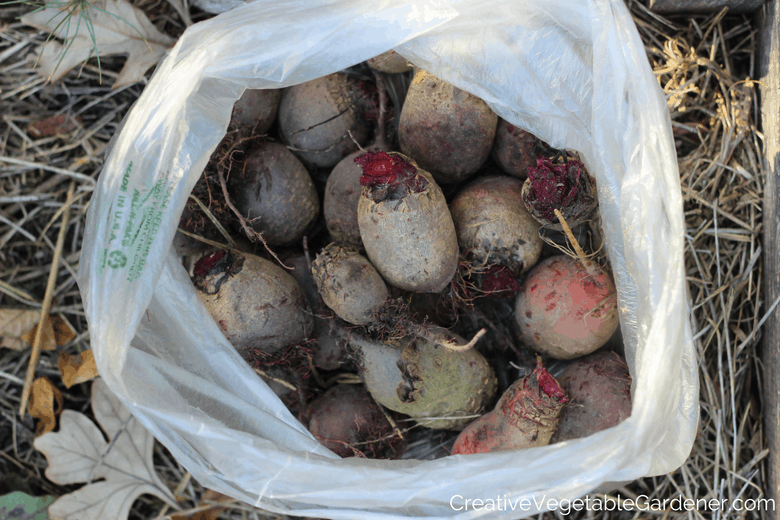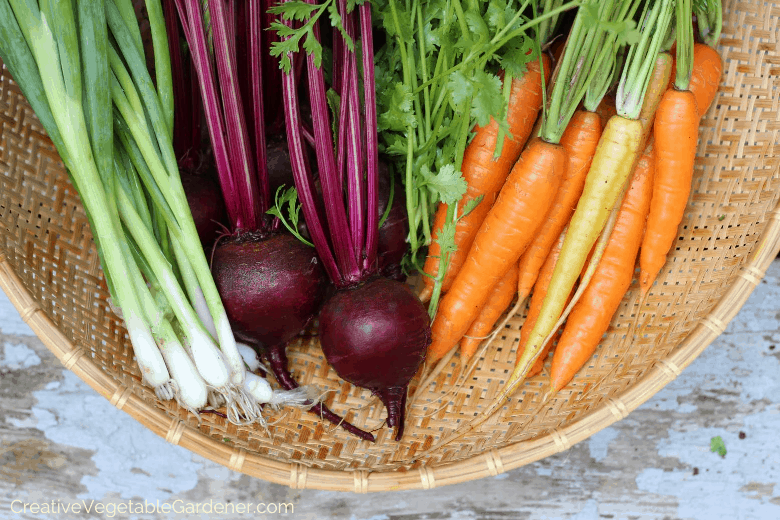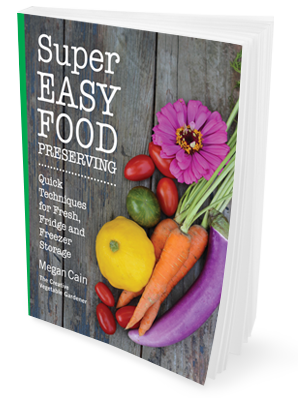How To Store Garden Carrots Over Winter

A common thing that happens in our gardens is that we end up planting too much of some vegetables and then come harvest time we have more than we can possibly eat.
Beets are definitely one of these vegetables!
No matter how much you love beets (there's a phrase I would never have written 15 years ago…) if you've grown a bumper crop, you might find yourself wondering, "What am I going to do with all of these?"
You might start thinking that you have to spend an afternoon in your kitchen canning a big batch of pickled beets. Or you may wonder which of your neighbors is secretly a beet lover and would be delighted to receive a surprise bag of beets on their front steps this weekend.
But, what if I told you there's really no such thing as too many beets? Would you believe me?
This is only true if you know how to store beets easily and quickly.
And if it's fall, I have good news. It's simple to store beets for use in savory recipes all winter long. I've harvested beets from my garden in late October in zone 5, stored them using the method I describe below, and was still using them fresh the next April and May.
That's over 6 months of storage!
Let me share my secrets with you, so you'll never have to say, "I grew too many beets." again.

How to store beets quickly for winter (or anytime!)
Spring Planted Beets
Beets are a frost hardy vegetable that can be planted about four weeks before your average last frost in spring. Many gardeners plant their beets in spring. Beets take about 65 days to grow, so you'll likely end up harvesting your beets in early summer.
You don't necessarily have to harvest the entire bed at once. I usually go through the rows and remove the biggest beets for eating and leave the smaller ones to grow a bit bigger.
The challenge of this time of year is that plants grow quickly, so you'll want to keep your eye on your beets to make sure they don't grow huge when you're not looking. I think they taste better when they're bigger than golf ball size, but smaller than a baseball.

Fall Beets
You can keep planting beets until about 6-8 weeks before your average first frost in fall. If you love beets, you should definitely grow a fall crop. Read exactly how to plant and grow fall beets.
When you've grown a great crop of fall beets, the first thing to know is that beets are extremely cold hardy. They can survive in the garden down into the mid-20's F.
So, it makes sense to take advantage of the natural refrigeration of the fall and early winter weather and keep them outside in your garden as long as possible.
You can harvest them as you need them for cooking and eating, but feel free to leave the rest in the garden bed. Unlike in the spring, plant growth slows down in the fall so there's not much chance of them growing too large.
They'll turn to mush if you let the ground freeze around them, so make sure you harvest the entire bed before that happens. Here in Madison, WI (zone 5), I generally clear out my bed of beets sometime in October or early November at the latest, or when the forecast calls for nighttime temperatures into the mid-20's.
>>Fall is my favorite gardening season! Learn all about how to increase the amount of food you get from your garden by planting a fall garden in this free mini-course.

Directions for How to Store Beets
Whether it's summer or fall, when you're ready to store your beets, here's what to do:
Step 1: Harvest
Harvest all of your beets. Brush off any excess soil back into the garden bed. I like to harvest all of mine into a crate for easy transport.
Step 2: Gather Supplies
Grab a pair of garden scissors and some plastic bags. You can use plastic handled bags, produce bags, or any other plastic bag you have around.
Step 3: Remove Greens
Remove the greens from the beets by cutting them with the scissors pretty close to the top of the beet root.

Step 4: Sort and Save Greens
Don't forget that beet greens are edible! After removing the greens from the beets I sort through the leaves and put aside the best looking ones. I keep these in a bag in the fridge for using in our lunch wraps (we eat a lot of them!) or I freeze them like I freeze kale for use all winter long in various dishes. Sometimes I mix kale and beet greens in the same bag for freezing. Crazy, I know!
Optional Step: Dry Out Beets
If your beets are wet and muddy, maybe because it's rained recently, or you have heavy soil, you may want to lay them out to dry before putting them into storage.
Spread newspaper or a tarp in a location out of the elements and freezing weather, a heated garage or your basement. Lay the beets out in a single layer overnight to dry and then continue with the remaining steps.
Don't leave them out too long or they'll become limp!
Step 5: Load into Bags
Transfer the beets into the plastic bags with the soil on. This is an important step! Do not wash your beets before storage. Many vegetables have a waxy layer that protects them, and if you scrub this off by with washing you'll compromise their storage life.
If you're only storing a small amount of beets for a short period of time you can feel free to wash them clean.
Step 6: Create Air Holes
Poke a few small holes in the bags to let moisture and humidity escape. I've found this keeps the beets drier in storage so they last longer.
Step 7: Store Beets
Clear some space in a back corner of your fridge and transfer the bags of beets there. I usually store my beet harvest in the back part of the lowest shelf so they're out of the way.
A common question I get when I talk about this in workshops is "Do you have two fridges?". I don't. I have plenty of room in my fridge for vegetables. In fact, that's all we have in there except for a few condiments. If your fridge is full to bursting it might be time to clean it out.
I find that a minimalist fridge helps me avoid food waste and keep on top of what's actually in there so I can use it up. There's also only two of us in our household, so that helps, too.
Step 8: Clean As You Need Them
When you need beets for a recipe, take a portion from the bag, scrub them off in a bowl of water, and use them. I usually dump the dirty water on our compost pile instead of sending the soil down the drain. Easy peasy!
Step 9: Check the Beets in Storage
Check the beets periodically to make sure none of them are rotting and infecting the rest of the bag. (You know what they say about one bad apple…err, beet…?!)

What should you do with the greens?
Leaf miner can be a problem in my garden, so often my leaves are pretty destroyed by the time I harvest them. If that's the case for you, too, you can place them in your compost bin.
If the beet greens look great, then you should eat them! We like to use beet greens in our lunch wraps. You can really use them in anything you'd regularly use kale, chard or spinach. If you have a lot of greens you can also freeze them for later use by using the same method I explain for freezing kale.
How long do beets store?
I've had beets store with this method until the April and May of the following year. So long that by the time I got to the end of the multiple bags of beets I was sick of them.
(This must be why I rarely plant spring beets…)
If you're wondering how to store carrots from the garden you can also use this exact same process and they'll last just as long.

Fresh, organic, local food can be difficult to find, and expensive to buy, in the winter. That's why if you love beets, you should prioritize growing fall beets and storing them for winter using this easy process.
This will give you quick access to your own produce without having to make a special trip to the grocery store for ingredients.
And if you also store homegrown onions, dry garlic, put away potatoes, and keep carrots fresh in your house you have the makings of an amazing winter meal right from your own pantry.
Additional Resources for Easy Food Preserving & Storage
FREE MINI-COURSE: Get Started Stocking Your Pantry for Winter.On a cold winter evening there's nothing quite like using produce you put away yourself during the growing season.
This mini-course features 5 videos + worksheets to help you:
- Deconstruct your favorite meals to set your food preserving priorities
- Explore 4 quick and easy options for preserving food (besides canning!)
- Discover delicious ideas for featuring your preserved food in healthy recipes all winter long
Start watching right now!
MASTERCLASS: Fill Your Pantry From Your Garden.
This winter, imagine grabbing all the ingredients you need for a meal right from your pantry, without having to go to the grocery store. With a few simple techniques you can continue to enjoy food grown in your own garden (or purchased from the farmers market) throughout the long, cold months of winter.
This class will teach you how to make every harvest last longer by quickly and easily preserving vegetables at the height of their season. You'll love the feeling of sitting down to a meal and knowing a large part of it came from your garden!
Join the Masterclass now!

Want more quick and easy ideas for preserving food?
In this book I'll teach you how to use your basement, fridge, and freezer to eat from your garden all 12 months of the year. Check it out here.
.
How To Store Garden Carrots Over Winter
Source: https://www.creativevegetablegardener.com/how-to-store-beets/
Posted by: winklerwhadminvabot.blogspot.com

0 Response to "How To Store Garden Carrots Over Winter"
Post a Comment